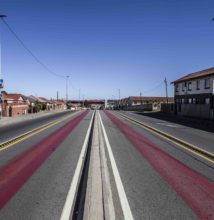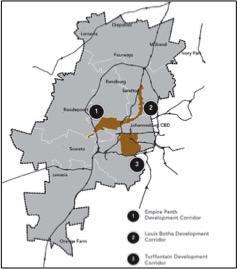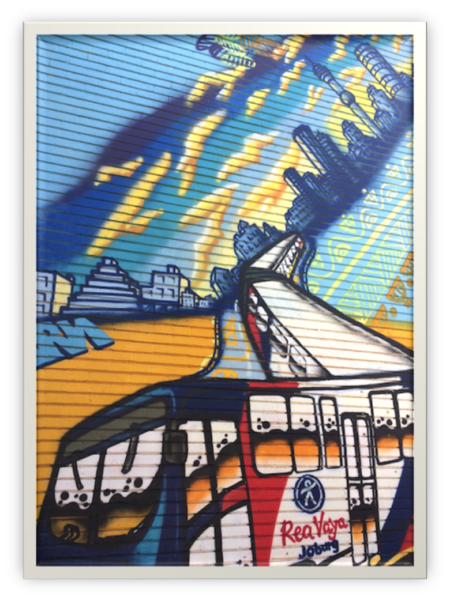The Corridors of Freedom Initiative
Romain Dittgen
Governing the Future City is an international ESRC-funded project looking at innovative approaches to urban governance and planning in Johannesburg, London and Shanghai. This blog, following on from an introductory article by Jenny Robinson and overview of research in the area of Lingang near Shanghai by Zheng Wang, discusses the ambitious Corridors of Freedom urban development programme in Johannesburg, South Africa.
 While having maintained – if not expanded – its position as a cross-regional economic hub drawing in large amounts of capital, ideas and people, Johannesburg has also remained very unequal and divided. This materialises both in the stubbornness of spatial segregation and in a very uneven distribution of wealth. As a result, the majority of the urban poor are still living at the margins of this sprawling metropolis, either housed in townships or in informal settlements with limited amenities and far away from job opportunities.
While having maintained – if not expanded – its position as a cross-regional economic hub drawing in large amounts of capital, ideas and people, Johannesburg has also remained very unequal and divided. This materialises both in the stubbornness of spatial segregation and in a very uneven distribution of wealth. As a result, the majority of the urban poor are still living at the margins of this sprawling metropolis, either housed in townships or in informal settlements with limited amenities and far away from job opportunities.
Against the backdrop of this continuous and multi-layered legacy of apartheid, the Corridors of Freedom (CoF) Initiative is therefore presented by the municipality of Johannesburg as a tremendous chance to stitch the city together and to break with the past. Since the initial introduction by the previous mayor in 2013, the CoF has featured as the City’s flagship project seeking to radically change the ways in which Johannesburg functions.
The initiative is expected to transform several pre-existent areas by connecting parts of the city via large transport corridors linked to interchanges around which the focus will be on mixed-use development and increased levels of accommodation density. Through the promotion of a combined ‘work, live and play’ function, the main objective of this large-scale and long-term undertaking is to help produce an integrated, ‘people-centred’ and compact city. The Bus-Rapid-Transit (called Rea Vaya), gradually rolled out along selected routes, forms the backbone of the Corridors and builds on the belief that an effective and interconnected public transport system will improve people’s access to amenities, facilities, work and leisure activities.

In contrast to the more ‘typical’ and contiguous urban mega-projects (such as new town developments, satellite cities or the regeneration of existent areas), the layout of the Corridors of Freedom initiative is quite different. The spatial footprint of the Corridors is extensive and the project itself is subdivided into distinct segments tied to specific temporalities. In the medium-term perspective, the focus of investment is presently directed at a route that is starting in the southwest (near Noordgesig and Pennyville), running past the Inner City CBD (this whole segment is referred to as Empire-Perth Corridor) before taking a sharp northern turn towards the financial centre of Sandton and the nearby township of Alexandra and Marlboro in the northeast (this segment is called Louis Botha Corridor). The third identified Corridor (Turffontein) sits south of the Inner city taking the shape of a square-like bloc without a direct link to the other two aforementioned corridors. If Soweto and the Mining Belt are flagged as current target areas, the former benefited from a range of investments and upgrades in the lead up to the 2010 World Cup whereas the latter has, thus far, only been identified as a priority investment area for future developments. In the long term, the CoF project is projected to establish further connections in the northern parts, between Sandton/Randburg and Diepsloot as well as between Alexandra and Ivory Park.
Apart from the goal to move away from the negative effects of urban sprawl and of a car-orientated city, the ambitious CoF project is underpinned by a strong social and developmental agenda. As such, the idea is to render neighbourhoods more multi-functional and complete while transforming the societal character and have ‘rich and poor, black and white living side by side’.[1] The Corridors of Freedom initiative, as implied by the name, therefore intends to provide not only increased freedom of movement for residents but also improved economic freedom by bringing poorer and marginalised population categories closer to the urban core, offering better opportunities for work, education, leisure and recreation.

However, changing overly rigid spatial characteristics and entrenched societal habits is challenging and requires a long-term approach as well as buy-in from other players. If the City of Johannesburg is the main driving force behind the project and currently rolling out the necessary bulk infrastructure and maintenance work, the implementation of the second phase of the project (i.e. densification of the housing component) is heavily dependent on the interest and involvement of private developers. Given the discrepancy of a socially motivated impetus on the one hand and a purely market-driven approach on the other hand, it is crucial to reach an alignment of interests (as well as of temporalities) between the municipality and a very heterogeneous property industry that remains highly risk adverse and location focused. Communities along the corridors, although portrayed at the heart of this initiative, usually sit at the bottom end. Nonetheless, due to the spatial spread of the corridors, running through a significant number of neighbourhoods with differentiated socio-economic realities, communities are very diverse and have been engaging more or less actively in the process.
Composed of local government structures, segments of the property industry and a wide range of communities, the success of an initiative of this scale will rely on the level of commitment and embeddedness both within and between each segment of this complex nexus. This becomes even more evident following the change in government after the recent local elections in August 2016, introducing a realm of uncertainty and questions about the continuity of political support for the project.
[1] This is drawn from the official website of the Corridors of Freedom Initiative [http://www.corridorsoffreedom.co.za].